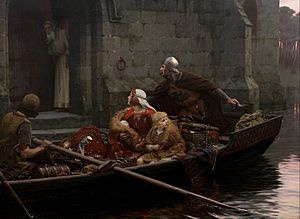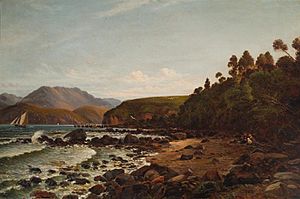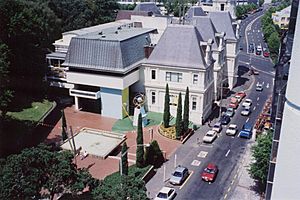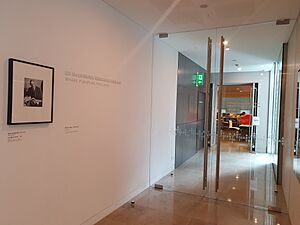Auckland Art Gallery facts for kids
Quick facts for kids Auckland Art Gallery Toi o Tāmaki |
|
|---|---|
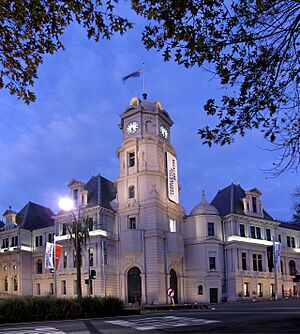
The gallery building, showing the clock tower
|
|
| Former names | Auckland City Art Gallery |
| General information | |
| Type | Art gallery, formerly public library and council offices |
| Architectural style | French Renaissance |
| Location | Corner Wellesley and Kitchener Streets, Auckland CBD |
| Coordinates | 36°51′05″S 174°45′59″E / 36.8514°S 174.7663°E |
| Completed | 1887 |
| Owner | Auckland Unlimited, Auckland Council (indirectly through Auckland Unlimited) |
| Design and construction | |
| Architect | John Harry Grainger & Charles D'Ebro; refurbished by FJMT + Archimedia (2011) |
| Awards and prizes | 2013 World Building of the Year, World Architecture Festival |
| Designated: | 11-Nov-1983 |
| Reference #: | 92 |
The Auckland Art Gallery Toi o Tāmaki is the main art gallery in Auckland, New Zealand. It holds the largest collection of art from New Zealand and around the world. The gallery often hosts exciting international art shows.
Located near Albert Park in central Auckland, the gallery first opened in 1888. It was the first permanent art gallery in New Zealand.
When it first opened, the building was home to both the art gallery and the Auckland public library. Its first collections came from generous gifts by Governor Sir George Grey and James Tannock Mackelvie. The Auckland Art Gallery was the second public art gallery in New Zealand. The first was the Dunedin Public Art Gallery, which opened in 1884.
In 2009, the gallery received an amazing gift of artworks from American businessman Julian Robertson. This collection was worth over $100 million, making it the biggest art donation ever in the region. These artworks were put on display in 2024.
Contents
Gallery History
For many years in the 1870s, people in Auckland wanted a public art collection. However, the city council was not ready to spend money on it. Important people like Sir Maurice O'Rorke pushed for it. The idea of a combined Art Gallery and Library became possible when two major supporters promised large art gifts.
One supporter was former colonial governor Sir George Grey. He had promised books for a city library as early as 1872. He eventually gave over 12,500 items, including many rare books, old writings, and 53 paintings. His gift included works by famous artists like Caspar Netscher and William Blake.
The other supporter was James Tannock Mackelvie, a businessman. In the early 1880s, he announced a gift of 105 framed watercolours and oil paintings. His total gift grew to 140 items, including paintings, decorative arts, and furniture. These items form the main part of the Mackelvie Trust Collection. A special room was set aside for his collection in 1893. Later, a new gallery space for it was built in 1916.
The Art Collection
The Auckland Art Gallery's collection started with mostly European old master paintings. Today, the collection has grown to over 15,000 artworks. It includes many different periods, styles, and types of art. You can find art from New Zealand, the Pacific, Europe, and from the Middle Ages right up to today.
Famous New Zealand artists with many works in the collection include Gretchen Albrecht, Marti Friedlander, C.F. Goldie, Frances Hodgkins, Gottfried Lindauer, and Colin McCahon. Some of these artists even donated their own works.
Special Gifts to the Collection
- Partridge Collection: In 1915, Henry Partridge, an Auckland businessman, gave a collection of paintings of Māori people by Gottfried Lindauer. He made this gift on the condition that Aucklanders raise 10,000 pounds for the Belgium Relief Fund. The money was raised very quickly.
- Wertheim Collection: Lucy Carrington Wertheim was an art gallery owner in London. She supported artists from New Zealand who lived overseas, like Frances Hodgkins. She gave the Auckland Art Gallery a great collection of British paintings from between the two World Wars. Her gifts in 1948 and 1950 included 154 works by modern British artists.
- Nan Kivell Collection: In 1953, Rex Nan Kivell donated an important collection of prints. These included works by George French Angas and Sydney Parkinson.
- Chartwell Collection: In 1997, the Chartwell Collection was moved to the Auckland Art Gallery for a long-term loan. This collection, started in 1974 by Rob Gardiner, has over 2000 items. It is often featured in the gallery's programs and special exhibitions.
- Dame Jenny Gibbs Gifts: Dame Jenny Gibbs has been a long-time supporter of the gallery. She has made many important gifts, often to mark special occasions. These include paintings by Colin McCahon, Gordon Walters, and Ralph Hotere.
- Robertson Collection: In 2009, American investor Julian Robertson announced he would donate art worth $115 million to the gallery. This amazing gift included works by world-famous artists like Paul Cézanne, Paul Gauguin, Pablo Picasso, Henri Matisse, and Salvador Dalí. It was the largest art donation of its kind in Australia and New Zealand. After his passing in 2022, the collection became a permanent part of the gallery. It was fully displayed in 2024.
Google Art Project
On April 4, 2012, the Auckland Art Gallery joined the Google Art Project. This project allows people to explore art online from museums around the world. The gallery's director, Chris Saines, said it was a "fantastic opportunity" to share New Zealand and international art with everyone.
The Auckland Art Gallery added 85 artworks to the project. Fifty-six of these are from its New Zealand and Pacific collection, and 29 are by international artists. This means people can see New Zealand art up close, even if they are on the other side of the world!
Gallery Buildings
The main gallery building was designed by architects Grainger & D'Ebro from Melbourne. It was meant to hold the art gallery, city council offices, a lecture hall, and the public library. The building is made of brick and plaster in an early French Renaissance style. It was finished in 1887, and an extension was added in 1916. It has three floors, an attic, and a tall six-story clock tower. This building is considered a very important heritage site in New Zealand.
The original building eventually became too small for all the city council departments. After the Auckland Town Hall was finished in 1911, all council offices moved out. This allowed the gallery to expand its spaces, including adding workshops for art classes.
From 1969 to 1971, the building was updated, and a new wing and sculpture garden were added. This was made possible by a generous gift from Philip Edmiston. In 1971, the public library moved to a new building nearby.
In the late 2000s, a big new extension was planned. The gallery closed for these major renovations in late 2007 and reopened on September 3, 2011. During this time, temporary exhibitions were held at a different location.
The expansion cost NZ$113 million. The design by Australian architecture firm FJMT and Auckland-based Archimedia increased the exhibition space by 50%. This allowed for up to 900 artworks to be displayed. The new design also created special areas for education, children, and families. As part of the upgrade, older parts of the building were fixed up and restored to how they looked in 1916. The number of different floor levels in the building was reduced from 17 to just 6, making it easier to navigate. This redevelopment has won many awards, including the 2013 World Building of the Year.
E H McCormick Research Library
The E H McCormick Research Library is a special art library located inside the Auckland Art Gallery. It started in 1953 as a reading room. The library holds about 160 collections of historical documents, including records from different galleries in New Zealand and personal papers of artists. This includes the photographic archive of Marti Friedlander, which was added to the UNESCO New Zealand Memory of the World register in 2018.
Gallery Directors
Even though the gallery opened in 1888, it didn't have a full-time professional director until Eric Westbrook was appointed in 1952. Before that, the Head Librarian was in charge of both the gallery and the library.
Westbrook and his successor, Peter Tomory (who was director from 1955 to 1965), worked to make the gallery more modern. They tried to bring modern art to a public that was not used to it, and they faced resistance from the city council. Some exhibitions, like one featuring works by Henry Moore, caused arguments. One council member even compared a sculpture to "the buttock of a dead cow"! However, the public loved these shows, and they attracted record numbers of visitors.
In 1981, Rodney Wilson became the first New Zealand-born director of the gallery. By the end of his time in 1988, the gallery had doubled in size. It also hosted very popular exhibitions, like "Monet: Painter of Light" in 1985. Wilson also helped manage the famous Te Maori exhibition, which toured the United States and then New Zealand.
Christopher Johnstone followed Rodney Wilson as director in 1988. During his eight years, major exhibitions included "Pablo Picasso: The artist before nature" (1989) and "Rembrandt to Renoir" (1993), which attracted 210,000 visitors. He also helped open the New Gallery for contemporary art in 1995.
Here is a list of the gallery's directors:
- 2019–2025: Kirsten Lacy
- 2013–2018: Rhana Devenport
- 1996–2013: Chris Saines
- 1988–1995: Christopher Johnstone
- 1981–1988: Rodney Wilson
- 1979–1981: Grant Kirby (Acting Director)
- 1974–1979: Professor Ernest Smith
- 1972–1974: Richard Teller Hirsch
- 1965–1972: Gil Docking
- 1956–1965: Professor Peter Tomory
- 1952–1955: Eric Westbrook
Notable Exhibitions
The Auckland Art Gallery has hosted many important and exciting exhibitions over the years. Here are a few examples:
- 1954 Frances Hodgkins and Her Circle
- 1956 Henry Moore: an Exhibition of Sculpture and Drawings This show caused a stir but brought in huge crowds.
- 1963 Retrospective: M.T. Woollaston and Colin McCahon This was the first large show of works by painters born and living in New Zealand.
- 1967 Marcel Duchamp, The Mary Sisler Collection: 78 Works 1904 – 1963
- 1971 Ten Big Paintings The gallery asked ten artists to create large paintings of the same size.
- 1975 Van Gogh in Auckland
- 1985 Claude Monet: Painter of Light This was one of the most successful exhibitions ever at the gallery. It attracted 175,679 visitors!
- 1987 Te Māori (presented in New Zealand as Te Māori-Te Hokinga Mai)
- 1988 Colin McCahon: Gates and Journeys This was the gallery's 100th anniversary exhibition.
- 1995 Paul Gauguin: Pages from the Pacific
- 2002 The Walters Prize 2002 This started a series of shows that highlight modern New Zealand art.
- 2014 Modern Paints Aotearoa This exhibition looked at how paint affected the work of New Zealand artists.
- 2015 Lisa Reihana: in Pursuit of Venus [infected]
- 2018 The Māori Portraits: Gottfried Lindauer's New Zealand: Te Hokinga Mai
- 2020 Toi Tū Toi Ora: Contemporary Māori Art This huge exhibition featured over 300 artworks by 110 Māori artists. It filled the entire gallery and attracted over 191,000 visitors.


